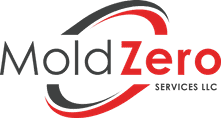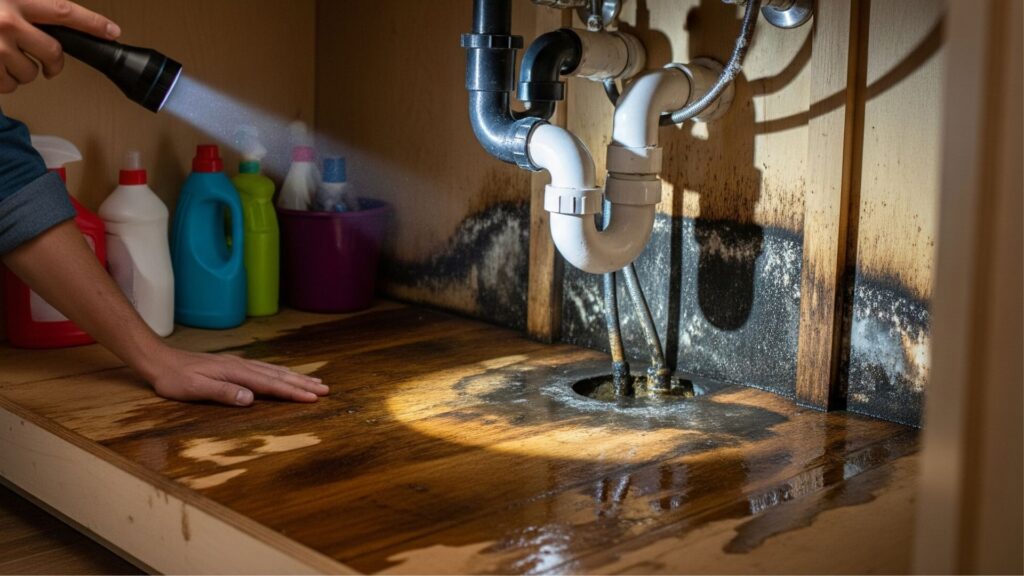Common Mold Household Hiding Spots in LA
Understanding Why and Where Mold Appears
Mold is a type of fungus that thrives in environments with adequate moisture, a food source like drywall or wood, and moderate temperatures. For property owners in Los Angeles, understanding where to look for mold is the first step in protecting their investment. While it can appear anywhere, certain areas of a home or business are significantly more susceptible to growth. These top spots for mold growth often combine poor ventilation with a consistent source of humidity or a hidden water leak.
A musty smell is often the first indicator that a problem exists, even before any visible signs appear. Being proactive and knowing the common places for mold can help you identify a potential issue early. When you do find something concerning, it’s crucial to have a trusted partner. Mold Zero has served the Los Angeles community for years, completing over 1,000 remediation jobs with our unique, minimally invasive process. Our NORMI certified professionals are experts at identifying and addressing mold issues, providing clarity and a reliable solution for homeowners and business owners alike.
The Importance of a Professional Assessment
While this guide will help you identify potential problem areas, a visual check can only reveal so much. Mold often grows in places you cannot see, such as behind walls or under flooring. This is where a professional inspection becomes invaluable. An expert can assess the conditions that lead to growth and identify hidden mold in a house that a property owner might miss. At Mold Zero, we offer a free, no-obligation inspection to residents in Los Angeles and surrounding areas like San Marino. We believe in empowering property owners with accurate information so they can make the best decision for their property. If you suspect an issue, don’t wait for it to become a larger problem. Contact our team to schedule your inspection and get the answers you need from a trusted, experienced source.
The Obvious Culprits: High-Moisture Environments
Bathrooms: A Prime Environment for Growth
It should come as no surprise that bathrooms are one of the most common places for mold. The constant use of showers and tubs generates a significant amount of steam and humidity. If your bathroom lacks proper ventilation, this moisture-laden air settles on surfaces, creating the perfect breeding ground. Check around the edges of the bathtub and shower, paying close attention to tile grout and caulking, which can degrade over time and trap water. The area around the base of the toilet is another spot to watch, as condensation or a faulty wax ring can introduce persistent moisture. Don’t forget to look under the bathroom sink. A slow, unnoticed drip from the P-trap or supply lines can saturate the cabinet wood, leading to a significant mold colony completely out of sight. A persistent musty odor in a bathroom that doesn’t go away after cleaning is a strong indicator that you may have a hidden issue that requires a professional assessment.
Kitchens: More Than Just a Place to Cook
Your kitchen is another hub of moisture-producing activities. The area under the kitchen sink is a top spot for mold growth, often due to minor leaks from the garbage disposal, dishwasher connections, or drain pipes. Even a tiny, slow leak can create a perpetually damp environment inside the dark cabinet. Refrigerators with ice makers or water dispensers have water lines that can leak, causing mold to grow on the wall behind them or on the floor beneath. The refrigerator’s drip pan is also a common culprit.
Dishwashers themselves can harbor mold, especially around the rubber seal of the door. Steam from cooking can also lead to issues, so check the wall behind your stove and the surfaces of nearby cabinets. Even small appliances like coffee makers can create damp conditions on the counter beneath them. Regularly inspecting these areas is a key part of any household mold inspection checklist.
Laundry Rooms, Basements, and Crawl Spaces
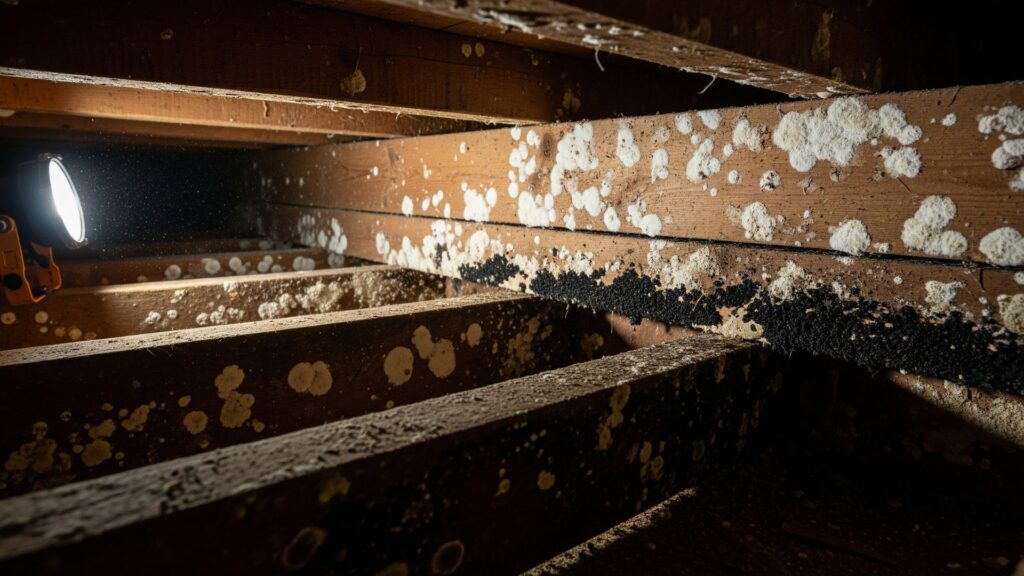
Laundry rooms, basements, and crawl spaces are often neglected but are major hotspots for moisture. In the laundry room, inspect the seal on front-loading washing machines, as they are notorious for trapping water and developing mold and odors. Check the connections for the water supply hoses and ensure the dryer vent is properly connected and clear of lint, as poor ventilation can push humid air back into the room. Basements, being below ground level, are naturally prone to dampness and water intrusion through foundation walls. Any signs of water seepage after a heavy rain should be addressed immediately.
Crawl spaces are particularly vulnerable, with moisture from the earth creating a humid environment that can affect the entire structure of your home. Poor ventilation in these spaces traps this moisture, promoting widespread growth on floor joists and subflooring. If you notice a musty smell rising from your floors, it’s a strong sign you need to investigate the crawl space or basement.
Uncovering Hidden Mold in Your House: Beyond the Surface
The Telltale Signs of Hidden Mold
One of the biggest challenges for property owners is that mold problems are not always visible. Finding hidden mold requires knowing what secondary clues to look for. These signs of hidden mold often point to a larger issue behind a wall, under a floor, or above a ceiling. If you notice any of these indicators in your Los Angeles home, it’s a signal to investigate further. A professional inspection from a NORMI certified expert like those at Mold Zero can confirm the presence of mold and determine the extent of the problem without unnecessary damage to your property. Pay close attention to these warning signs:
- A Persistent Musty Odor: This is the most common and reliable sign. If you notice a damp, earthy, or stale smell that you can’t trace to a specific source, it’s very likely there is a hidden mold colony somewhere in the vicinity.
- Visible Stains or Discoloration: Unexplained stains on walls or ceilings, especially those that are yellowish or brownish, can indicate a water leak behind the surface. These damp areas are ideal for mold growth.
- Peeling, Bubbling, or Cracking Paint: When drywall becomes saturated with moisture, the paint on its surface will often begin to bubble, peel, or crack. This is a clear sign of a moisture problem within the wall cavity.
- Warped or Bowing Walls: Moisture can cause building materials like drywall and wood paneling to swell and warp. If you notice a section of a wall is no longer flat, it could be due to a significant, long-term leak and associated mold growth.
- Deteriorating Grout or Caulk: In bathrooms and kitchens, crumbling caulk or grout can be a sign of moisture getting behind tiles, which is a prime location for hidden mold to flourish.
Finding Mold Behind Walls and Above Ceilings
The space inside your walls and above your ceilings is dark, undisturbed, and often contains organic food sources like paper-backed drywall and wood studs. When a water source is introduced from a leaky pipe, a faulty roof, or even condensation, it creates the perfect hidden incubator for mold. Finding mold behind walls is a common scenario following plumbing failures or slow leaks that go undetected for months or even years.
You might notice a soft spot on the drywall or see discoloration seeping through, but often the only clue is a localized musty smell. Attempting to open up a wall without a proper containment strategy can release a large number of mold spores into your property’s air, potentially spreading the problem to other areas. This is why professional intervention is critical. Our team at Mold Zero has addressed these exact situations in over 1,000 properties. We use a methodical approach to identify the source of the moisture and address the mold with our minimally invasive process, which is designed to be fast and effective while respecting your home.
Attics and HVAC Systems: The Unseen Networks
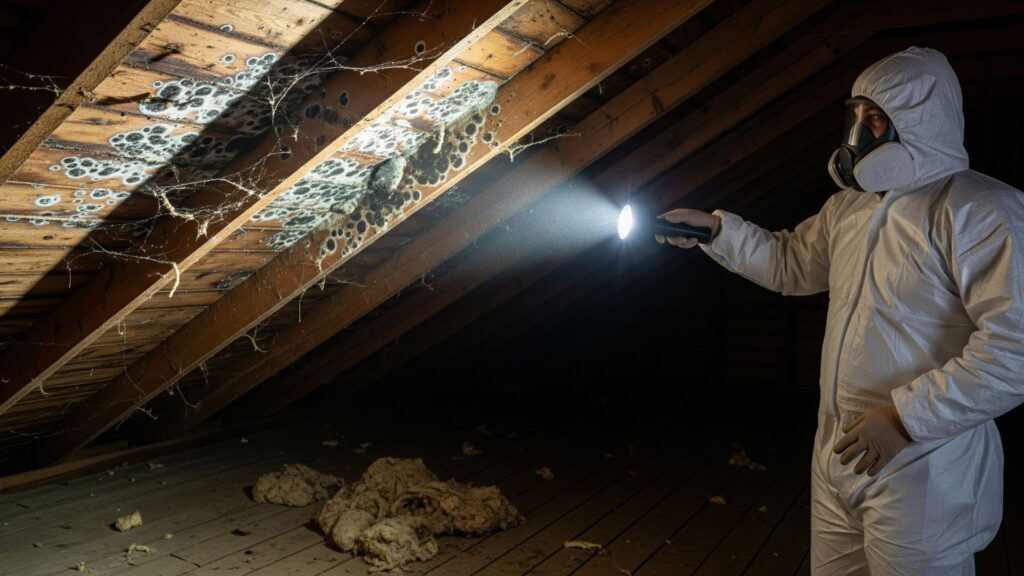
Attics are another one of the top spots for mold growth that often goes unchecked. Poor ventilation is a primary cause. When warm, moist air from the living spaces below rises into a cold attic, condensation can form on the underside of the roof sheathing, creating a damp environment. A leaky roof is another obvious culprit, allowing rainwater to saturate insulation and wood rafters. Inspect your attic for mold for dark staining on the wood, damp or compressed insulation, or a musty smell.
Your HVAC system can also become a source and a distribution network for mold spores. The evaporator coils in your air conditioning unit are constantly wet when the system is running, and if not properly maintained, they can become a breeding ground. Mold can then grow within the drip pan and ductwork. When you turn on your system, it can circulate spores throughout your entire Los Angeles property. If you notice a musty odor only when the air conditioner or heater is running, it’s a strong sign that your HVAC system needs a professional inspection.
Your Proactive Household Mold Inspection Checklist
Regular Checks You Can Perform Yourself
Staying vigilant is key to protecting your property from the issues mold can cause. By incorporating a simple household mold inspection checklist into your regular maintenance routine, you can catch potential problems early. This proactive approach helps you spot the initial signs of water intrusion or moisture buildup before they escalate into a more significant concern.
While this checklist is a great starting point, remember that it cannot replace a comprehensive evaluation from a trained professional, especially if you already suspect an issue. Here are some regular checks you can perform:
- Monthly Under-Sink Inspections: Once a month, use a flashlight to check under every sink in your home—kitchen, bathrooms, and utility room. Look for any signs of drips, water stains, or dampness on the pipes and the cabinet floor.
- Appliance Hose and Seal Checks: Regularly inspect the hoses connected to your washing machine, dishwasher, and refrigerator ice maker. These can become brittle and crack over time. Also, wipe down and dry the rubber seal on your front-loading washer after use.
- Window and Windowsill Monitoring: Look for condensation on the inside of your windows, especially during colder months. Excessive “sweating” indicates high indoor humidity, which can lead to mold growth on windowsills and surrounding walls.
- Closet and Storage Area Sniff Test: Periodically open closets, pantries, and other storage areas to check for musty odors. These enclosed spaces often have poor air circulation, making them susceptible if any moisture is present.
- Exterior and Foundation Walk-Around: After a heavy rain, walk around your property’s exterior. Look for areas where water pools near the foundation and ensure gutters and downspouts are directing water away from the house.
When to Call a Los Angeles Mold Remediation Expert
Self-checks are useful, but there are clear situations where you need to call in a professional. Guessing about a mold problem can lead to improper cleaning attempts that may spread the issue or fail to address the underlying cause. If you encounter any of the following, it is time to contact the NORMI certified experts at Mold Zero for a free inspection.
We provide clear, honest assessments for property owners throughout Los Angeles and San Marino. Our goal is to give you the information you need to make a confident decision. Call us immediately if you experience one of these scenarios: you have discovered what you believe is visible mold growth, especially if it covers an area larger than a few square feet; you smell a persistent, musty odor that you cannot locate; your property has recently suffered from a flood, a significant plumbing leak, or any other water damage event; you are preparing to buy or sell a property and want to ensure there are no hidden mold issues.
Don’t risk your property’s integrity or the well-being of its occupants. A call to Mold Zero at (626) 671-8885 is the definitive step toward resolving the problem correctly and efficiently.
The Mold Zero Difference: A Comprehensive Solution
Our Unique and Minimally Invasive 5-Step Process
When Los Angeles property owners face a mold issue, they need a solution that is not only effective but also respects their time and property. Traditional remediation can be a lengthy, disruptive process involving extensive demolition. Mold Zero offers a better way. Our unique 5-step process is designed to be incredibly fast—often completed in just hours, not days—and minimally invasive. We focus on addressing the root of the mold problem without turning your home or business into a construction zone.
This efficiency means less disruption for you, your family, or your employees. Our process begins with a thorough assessment to understand the full scope of the issue. We then employ our advanced methods to neutralize mold on contact and address the airborne spores throughout the property. This comprehensive approach ensures we are not just treating the visible symptoms but resolving the entire problem, which is why we have been trusted with over 1,000 remediation jobs.
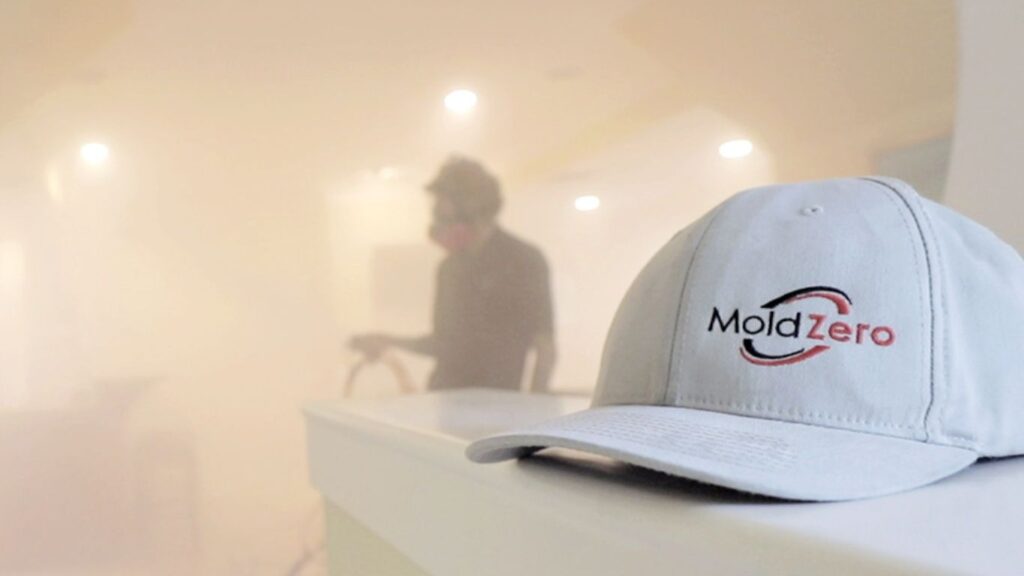
Trust Backed by Proof: Our Guarantee and Verification
At Mold Zero, we believe that trust is earned through transparent results. We stand confidently behind our work, and we provide you with multiple layers of assurance. First, we back every one of our remediation projects with a 1-Year Guarantee. This is our promise to you that our solution is lasting and effective. Second, and most importantly, we prove our results with data. After our process is complete, we use an independent, third-party laboratory to conduct post-treatment verification testing.
This unbiased analysis confirms that the mold issue has been successfully addressed according to industry standards. You don’t have to simply take our word for it; you get impartial, scientific proof of a job well done. This commitment to verification, combined with our “Family First” philosophy of using solutions we would trust in our own homes, provides our clients with unparalleled peace of mind.
Your Next Step for a Resolved Mold Issue in Los Angeles
If you have identified any of the common places for mold in your home or are concerned about the signs of hidden mold, the time to act is now. Delaying can allow the issue to spread, potentially leading to more complex and costly property concerns. Protect your investment and support the indoor environment for your family or employees by taking decisive action. Contact the experienced, NORMI certified professionals at Mold Zero.
We are the trusted mold removal experts for homeowners, landlords, and business owners across Los Angeles and San Marino. Let our team of over 1,000 completed jobs put your mind at ease. Your path to a resolved mold problem starts with one simple step.
Call us now at (626) 671-8885 to speak directly with a specialist, or fill out the simple form on our website to schedule your free, no-obligation inspection and quote today.
